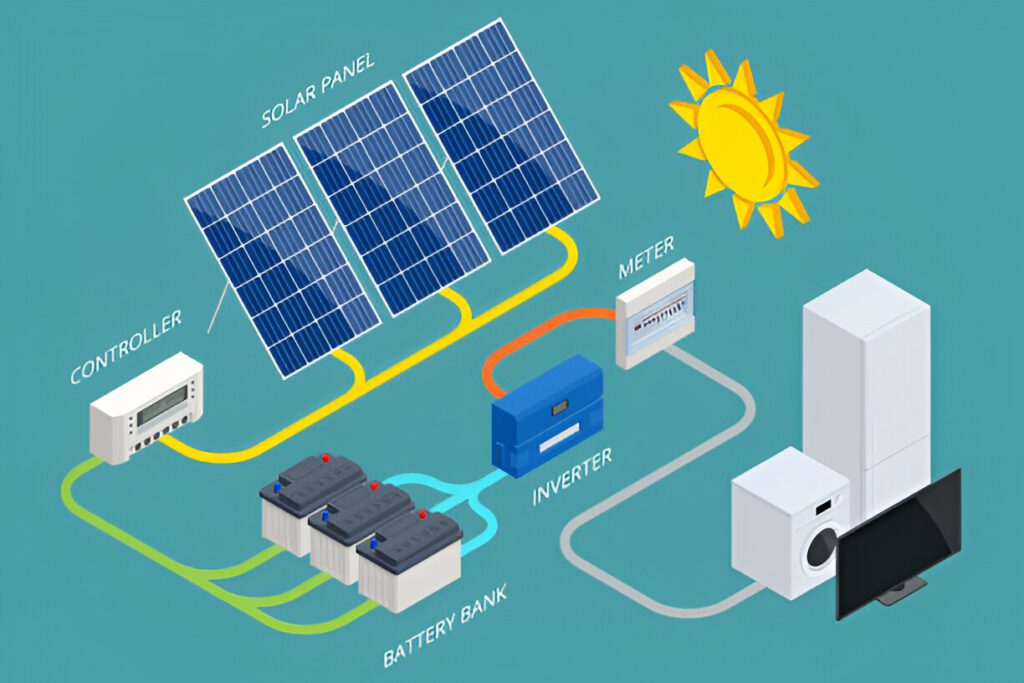Winter can be tough on solar power systems, especially if you live in a place with cold temperatures, snow, or ice. Solar Power System and Battery Bank need a little extra care to keep them running efficiently during the colder months. With a few simple steps, you can protect your solar power setup and make sure it stays safe and effective throughout winter.
In this article, we’ll cover helpful tips for winterizing your solar power system and battery bank.
Why Winterizing Your Solar Power System is Important
Cold weather can affect solar panels, batteries, and the entire solar power system. While solar panels can still work in the winter, they’re not as effective with less sunlight and shorter days. Snow, ice, and freezing temperatures can also impact your system, especially the battery bank, which stores energy for later use.
Winterizing your setup helps prevent damage, reduce energy loss, and keep everything running smoothly until spring.
1. Inspect Your System Before Winter Arrives
Before winter hits, inspect your solar power system and battery bank for any signs of wear or damage. Check that all cables, connectors, and panels are securely attached and that there are no cracks, loose wires, or rust. Damaged parts can lead to energy loss, and winter weather may make small issues worse.
Tip: Make a checklist for each part of the system and go through it carefully. This is also a good time to look for dirt, debris, or leaves that may have gathered around the panels.
2. Clean Your Solar Panels
Solar panels work best when they’re clean and free of dirt. Even in winter, dust and debris can block sunlight and reduce energy production. Cleaning them now will make sure they’re as efficient as possible before the snow arrives.
How to Clean: Use a soft brush or cloth with water to gently remove any dirt. Avoid using soap or chemicals, as they could damage the panels. Be careful not to scratch the surface.
Tip: Check your panels regularly in winter for any buildup of snow or ice, which can further reduce sunlight reaching the panels.
3. Adjust Panel Angle for Winter Sunlight
In winter, the sun is lower in the sky, which affects how much light hits your solar panels. Adjusting the angle of your panels to face the lower sun can help increase the amount of sunlight they receive. Most experts recommend tilting panels at a steeper angle in winter.
Tip: If you have a ground-mounted system, it’s usually easier to adjust the angle. For roof-mounted panels, consult a professional to safely adjust them.
4. Protect Your Battery Bank from Freezing Temperatures
Solar battery banks are more sensitive to cold temperatures than solar panels. When it gets too cold, batteries can lose capacity, which means they store less energy. Extreme cold can also cause batteries to stop working altogether, especially if they’re lead-acid batteries.
How to Protect: Keep your battery bank in an insulated box or move it to a warmer area like a garage. Some people use battery heaters, which wrap around the batteries and keep them warm.
Tip: Try to maintain a stable temperature for your batteries, ideally between 32°F and 77°F (0°C and 25°C) to keep them efficient.
5. Monitor Your System’s Performance
Winter sunlight is often limited, so it’s important to monitor your system regularly. Many solar setups have monitoring systems that let you check how much energy you’re generating and storing. Keeping an eye on these numbers can alert you to any drop in performance and help you catch issues early.
Tip: If you notice a big drop in performance, it could mean there’s a problem, like snow blocking the panels or an issue with the battery bank.
6. Clear Snow and Ice Carefully
Snow and ice can cover solar panels, blocking sunlight and reducing energy production. You don’t need to clear them after every snowfall, as panels can often melt snow on their own. But after a heavy snowstorm, it’s a good idea to gently remove the snow so your panels can work properly.
How to Clear Snow: Use a soft snow broom or a plastic shovel to carefully brush snow off the panels. Avoid using metal shovels or hard scrapers, as they could damage the surface.
Tip: A soft, extendable brush is great for roof-mounted panels, so you can clear them from the ground without climbing onto the roof.
7. Check and Adjust Your Backup System
If you rely on your solar power system to run essential appliances, you may need a backup plan for cloudy winter days when the sun is scarce. Consider having a generator or extra batteries as a backup to keep your devices running.
Tip: Test your backup system before winter to make sure everything is working properly and fully charged.
8. Consider Energy Conservation in Winter
Since your system might produce less energy in winter, consider conserving power whenever possible. Small steps, like using energy-efficient lighting, lowering thermostat settings, and unplugging unused devices, can help reduce the strain on your system.
Tip: Many people find that using power wisely can stretch their stored energy and keep the system running smoothly.
9. Consult a Solar Professional for Maintenance
If you’re new to winterizing or have a large solar system, consulting a professional can be very helpful. A solar technician can inspect your system, check for issues, and make sure everything is winter-ready.
Tip: Regular maintenance from a professional can extend the life of your solar power system and ensure it’s working at its best during winter.
Final Thoughts
Winterizing your solar power system and battery bank doesn’t have to be complicated. With some simple steps, you can protect your investment, improve energy efficiency, and keep your solar setup running even in colder months. From cleaning panels and adjusting angles to protecting your batteries and monitoring performance, a little winter prep goes a long way.

